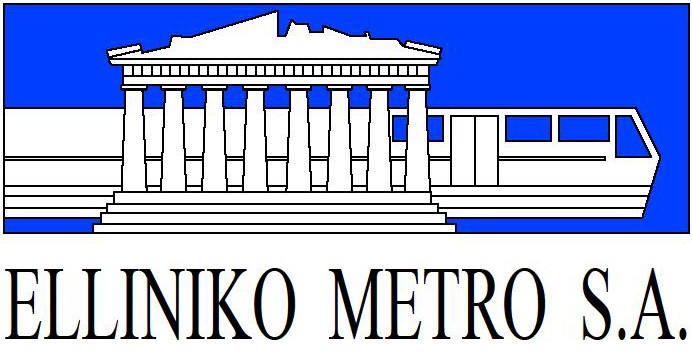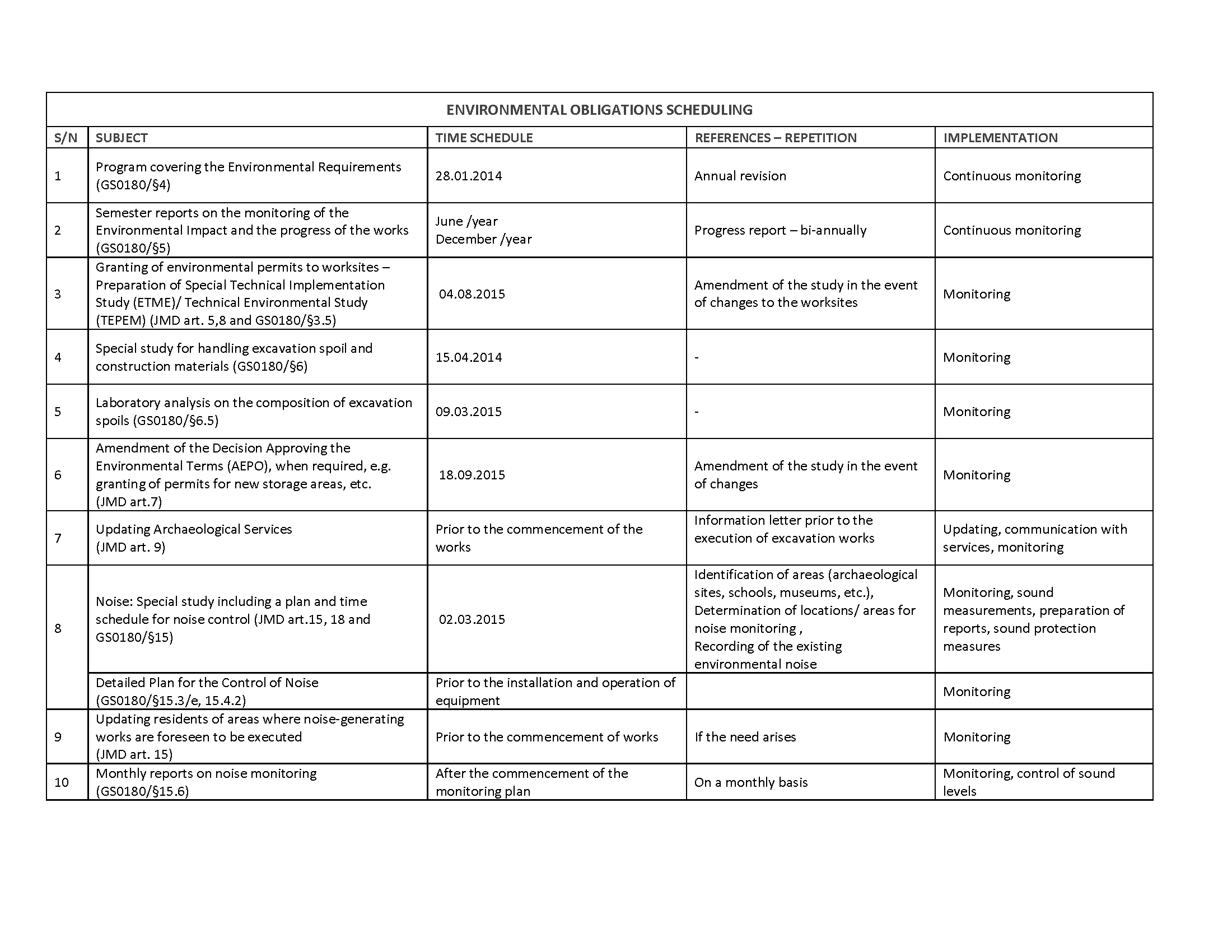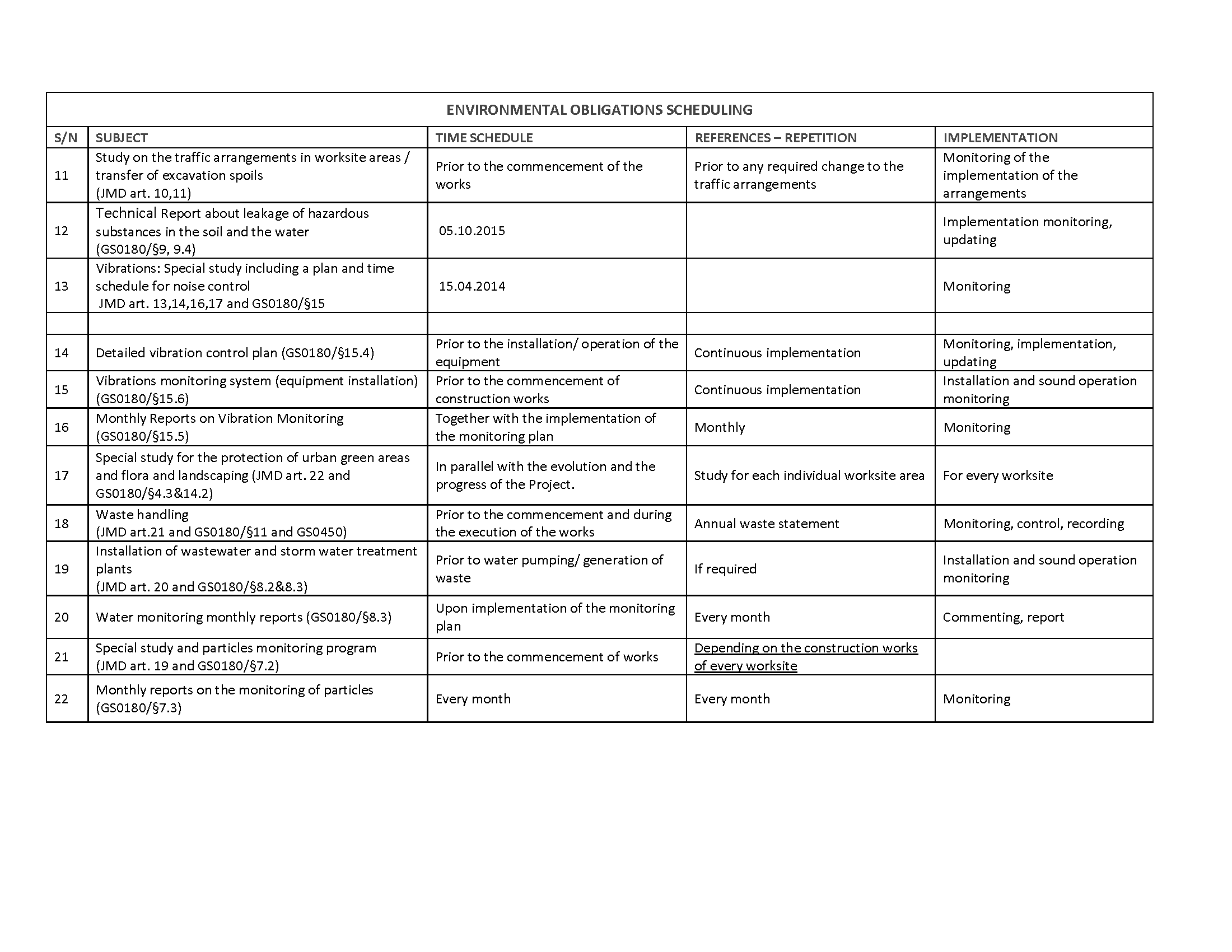1) INTRODUCTION
The current report proves adherence to the Environmental Requirements, which describe the required measures and processes, implemented as a whole, during the construction period of the Project, so as to ensure protection of the environment, as required by the tender documents and, especially, by article GS0180 of the document entitled General Specifications, the approved environmental terms of the Project and the applicable National and European Legislation.
2) ADHERENCE TO THE REQUIREMENTS
As of the beginning of the Project and in view of addressing wider environmental issues, a more generic environment-friendly approach has been followed for the entire Project, aiming at reducing the environmental pressure.
As of the phase involving the positioning of worksites, general service roads of the Project, designated disposal areas, the temporary concrete batch plants, etc., all applicable environmental terms and conditions have been taken into consideration in order to minimize any impact on the environment.
In particular and as concerns the environmental requirements, the following apply:
2.1 Worksite areas – works and activities
For the implementation of the Project, special worksites areas were organized. The environmental permits were granted for those areas, by virtue of paragraph 1, article 6 and paragraph 6 article 11 of Law 4014/11 (FEK 209 A/21-9-2011) “Environmental permitting for works and activities, environmental regulation of structures erected without planning permission and other provisions within the competence of the Ministry of Environment”.
The worksites’ location, activities, equipment, etc. derive further to the submissions and evaluations of designs, based on the applicable legislation.
The environmental measures are implemented on the basis of the approved time schedule and the works it involves.
2.2 Air-borne pollutants and particulate matter
The construction of the Project entails impact on the environment, a fact than can be dealt with the introduction of specific protection measures.
The aforesaid impact mainly involve dust and particulate matter deriving from various construction activities in the Project’s sections, from the temporary designated disposal areas, excavation spoil, the roads providing access to the Project, etc.
The protection measures aim at solving the problem of pollutants at their source, so that the emission of dust, particulate matter, etc. be minimized.
Dust is dealt with several means, such as constant sprinkling of dust-generating surfaces and vehicle circulation roads, impermeable covering to cover vehicles transporting excavation spoil, etc.. For the production of ready-made concrete, closed systems of wet type are used, which are described in detail in the permitting study for worksites and activities.
In addition, to avoid any dust emission, mechanical dust collectors are utilized, as applicable and feasible.
As concerns air-borne pollutants and particulate matter, the Contractor uses a special Environmental Process that has been submitted and approved by ELLINIKO METRO S.A. The control and monitoring results of the particulate matter and their evaluation are submitted along with the Environmental Monitoring monthly reports.
2.3 Noise and Vibration control Measures
The construction phase of the Project leads to various impact on the acoustic environment, which are dealt with specific protection measures.
The aforesaid impact concern noise and vibrations caused by the works for the implementation of the Project, the operation of the worksites, the transportation of excavation spoil, row materials, etc.
Adverse impact from noise and vibrations that may arise in the urban areas adjacent to the Project (man-made environment) or in archaeological areas, etc. are dealt with the introduction of appropriate protection measures, such as the use of sound-acoustic panels, sound absorbent materials, the use of soundproofing technology, with EC type-approval certificate, adherence to the public rest rules when using noisy machinery, information to the public in case of using noisy machinery.
The aforementioned measures are described in detail in the Special Study of Noise Control during the Construction and the Special Study of Vibration Control during the Construction, as these have been submitted to the service.
During the construction phase, a systematic monitoring is conducted using sonometers and vibrographs in order to record the noise and vibration levels of the Project. The Noise and Vibration control and monitoring results and their evaluation are submitted by the Contractor along with the Environmental Monitoring monthly reports.
2.4 Measures for controlling pollutants at surface water or groundwater and soil
During the construction phase of the Project there might be impact on water or soil environment, which are dealt with the introduction of suitable protection measures.
Water reservoirs
During the construction of the project, pollution-generating sources may involve pumping of groundwater, use of water in various construction activities – wherefrom waste may derive, liquid waste from the worksite concrete batch plants, etc., releases of waste (such as mineral oils) to the environment, earthing works (such as dust and particulate matter), liquid waste from worksite installations, etc.
The water pumped or used in underground works is collected into particulate matter sedimentation tanks, water sampling is carried out on a monthly basis and the processed clear water is channeled to the rainwater network of the city. Generally, in order to avoid any adverse impact on receiving water bodies, during the execution of earthworks, appropriate measures are introduced: e.g. temporary structures to retain solid particles so that receiving water bodies are not polluted and automated systems intended for water quality control prior to water outflow in EYATH network.
During the construction phase of the Project, soil pollution generating sources mainly involve execution of activities at the surface and in the tunnels of the Metro.
The environmental impact may derive from spillage of liquid waste and hazardous substances, spreading of solid waste, etc.
Hazardous solid or liquid waste is stored in especially designated areas and is transported for management purposes via official authorities licensed to take delivery and manage same.
2.5 Measures for managing hazardous solid, liquid and/or toxic waste
During the construction of the project, there might be various effects from hazardous waste. Adherence to the rules and requirements of the applicable legislation during the management of special and hazardous waste contribute to the protection of environment.
Waste derives from used mineral oils, chemical substances, other construction materials’ processing products, etc. Hazardous waste is collected in especially designated areas and is transported there from via official authorities licensed to take delivery and manage same.
2.6 Measures for managing excavation spoil, transport and disposal
Due to the fact that the Project is mainly underground, the construction of Metro stations and tunnels will produce excavation spoil.
As regards the excavation spoil of the Project, a more rational management is sought, as, for example their integration into the Project via the development of products or sub-products intended for its construction, to the extent that the technical and qualitative requirements of the Project allow so.
As regards the redundant excavation spoil of the Project, the initial provision was for them to be transferred to the area of construction of pier No. 6 at the port of Thessaloniki or, in case this is not possible, to designated environmentally licensed disposal areas to be selected based on the “Special Study for the Management of Excavation Spoil and Construction Materials”. These areas are as follows:
- Landfill at Tagarades
- Inactive quarry, property of TITAN CEMENT COMPANY S.A., located in an area of Nea Efkarpia outside the town plan
- Neochorouda inactive quarry, property of the Municipality of Oreokastro
- Paleokastro inactive old quarry for aggregates, property of the Municipality of Oreokastro
- Inactive quarry for aggregates, property of the company “Michael V. Kalogiannis & Co General Partnership”.
- Abandoned land borrowing site/sand and gravel quarry of the company “L. KENTEPOZIDIS & Associates General Partnership”.
- Landfill at Mavrorachi
2.7 Measures for the management of worksite areas and greenery, reinstatement works
During the construction of the Project, emphasis is placed on the protection of the existing greenery.
In the worksite areas, the terms of the environmental permit granted to these areas are observed and their reinstatement will take place upon completion of the works for the construction of the Metro project.
2.8 Measures to deal with the environmental degradation, safety of employees
The pre-existing environmental issues in the Project zone will be dealt with depending on the pertinent conditions and pollution.
2.9 Progress reports of the Project
Throughout the construction of the Project, the Contractor prepares semester reports on the monitoring of the environmental impact and the progress of the works, which are submitted to ELLINIKO METRO S.A.
2.10 Required Designs and environment related obligations
During the construction of the Project, the contracting company, apart from strict adherence to the environmental terms it exhibits, it takes into account the requirements of specification GS1100 “Archaeological works” of the tender document “General Specifications”, in combination with the time schedule and the scheduling of the Project works, aiming at minimizing any impact on the immediate and wider environment of the Project. The purpose is to promptly issue the environmental permit for the various activities and the associated facilities for the protection of the environment.
Monitoring and control related information shall be submitted on a monthly basis to ELLINIKO METRO S.A.
The environmental plan is updated every year, thus covering any new requirements that may occur.
2.11 Worksite areas – description
Worksite areas are in total 8, namely NOMARCHIA Station, KALAMARIA Station, ARETSOU Station, NEA KRINI Station, MICRA Station and crossovers, Krinis Shaft, Pontou Shaft and Nomarchia Crossover.
3) IMPLEMENTATION OF THE ENVIRONMENTAL MANAGEMENT SYSTEM
During the Project construction, ELLINIKO METRO S.A. implements an environmental management system certified per ISO 14001:2015, in view of adhering to the environmental requirements and ensuring the environmental management of all the environmental issues of the Project and its waste.
Every effort is made so that environmental issues and the implementation of measures contributing to the prevention of environmental impacts and pollution are rationally approached on a daily basis.
In the framework of the application of ELLINIKO METRO S.A. Environmental Management System, environmental audits, both regular and extraordinary, are carried out in every worksite area, meeting, thus, all the environmental specifications provided for in the Contract and the environmental terms of the project through an audit plan covering all the above requirements.




